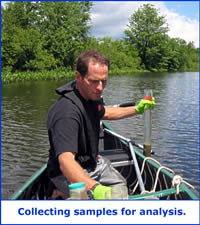EPA New England Regional Laboratory (Office of Environmental Measurement and Evaluation)
Sediment Oxygen Demand Studies
 Sediment Oxygen Demand (SOD) is the sum of all biological and chemical processes
in sediment that utilize (take up) oxygen. SOD studies are used in mathematical
models that aid in determining waste load allocations, which in turn are used
in determining Total Maximum Daily Loads and in NPDES permits. They are also
useful in measuring the depletion of oxygen in waters that have been stratified.
In these waters, the sediment and the bottom layer of water are somewhat "trapped" and
the oxygen is depleted as a result of decay of organic matter and lack of exchange
of oxygenated water from upper layers.
Sediment Oxygen Demand (SOD) is the sum of all biological and chemical processes
in sediment that utilize (take up) oxygen. SOD studies are used in mathematical
models that aid in determining waste load allocations, which in turn are used
in determining Total Maximum Daily Loads and in NPDES permits. They are also
useful in measuring the depletion of oxygen in waters that have been stratified.
In these waters, the sediment and the bottom layer of water are somewhat "trapped" and
the oxygen is depleted as a result of decay of organic matter and lack of exchange
of oxygenated water from upper layers.
 SOD studies involve collecting a sediment core sample, which is a vertical
column of a measurable volume of sediment and overlying water. The core
samples are brought to EPA New England's mobile laboratory for analysis.
The depletion of dissolved oxygen in the water column is measured over
a three hour time period, and from this the Sediment Oxygen Demand is
calculated.
SOD studies involve collecting a sediment core sample, which is a vertical
column of a measurable volume of sediment and overlying water. The core
samples are brought to EPA New England's mobile laboratory for analysis.
The depletion of dissolved oxygen in the water column is measured over
a three hour time period, and from this the Sediment Oxygen Demand is
calculated.
SOD studies are conducted in selected New England rivers each year. Recent studies have included the Royal, Penobscot and St. Croix rivers in Maine, and the Contoocook River in New Hampshire.
